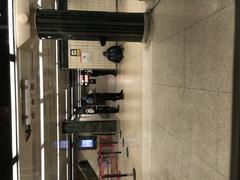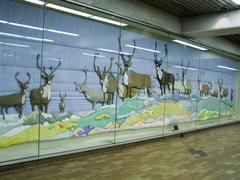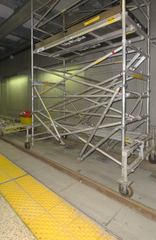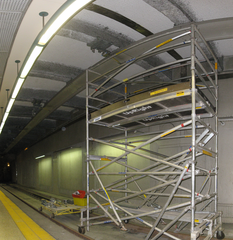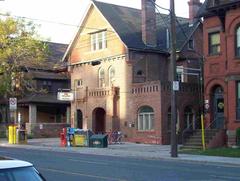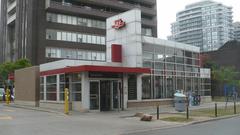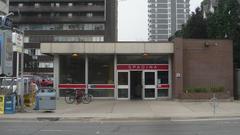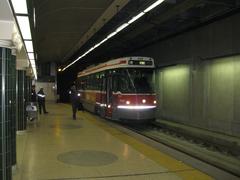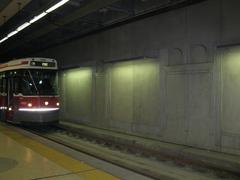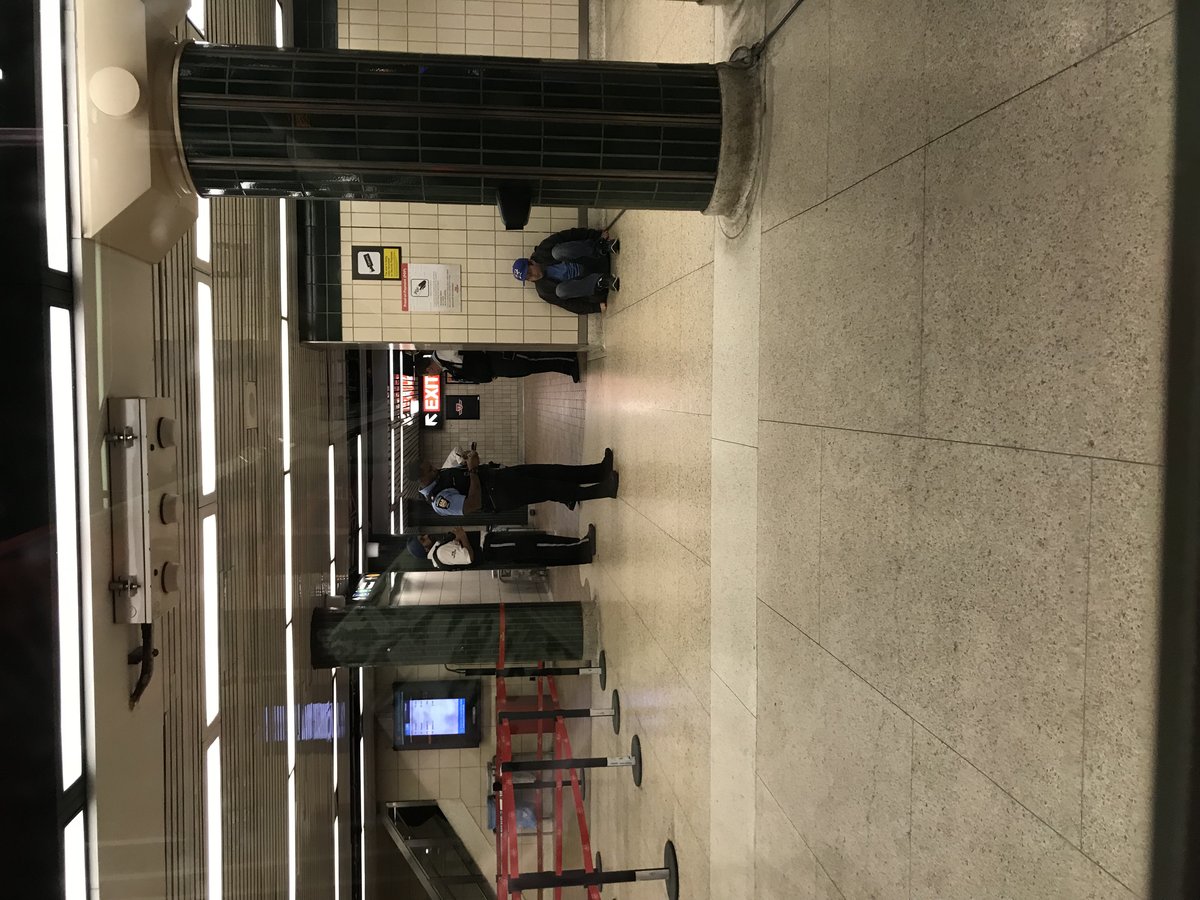
Spadina Station: Visiting Hours, Tickets, and Your Guide to Toronto’s Historic Transit Hub
Date: 15/06/2025
Introduction
Spadina Station is a cornerstone of Toronto’s public transit system, serving as a major interchange between Line 1 (Yonge–University) and Line 2 (Bloor–Danforth) subway lines as well as the terminus for the bustling 510 Spadina streetcar. Beyond providing seamless connections, Spadina Station stands as a testament to Toronto’s urban evolution, architectural ambition, and cultural diversity. Its name, derived from the Anishnaabemowin word “ishpadina” (“highland” or “ridge”), is a nod to the area’s Indigenous heritage. The station’s blend of modernist design, integrated public art, and proximity to some of Toronto’s most vibrant neighborhoods—including the Annex, Chinatown, and the University of Toronto—make it not just a transit stop but a gateway to the city’s rich history and culture.
This comprehensive guide details everything visitors, commuters, and architecture enthusiasts need to know: operating hours, ticketing information, accessibility features, historical context, travel tips, and nearby attractions. For up-to-date details, always check the official Toronto Transit Commission (TTC) website, Transit Toronto, and Spacing.ca.
Contents
- Introduction
- Visiting Hours and Ticketing
- Travel Tips for Visitors
- Accessibility Features and Upgrades
- History and Architecture
- Public Art at Spadina Station
- Cultural Context and Nearby Attractions
- Frequently Asked Questions (FAQ)
- Conclusion
- Sources
Visiting Hours and Ticketing
Operating Hours:
Spadina Station is open daily from approximately 6:00 AM to 1:30 AM, in line with standard TTC subway operations. The east side entrance at 7 Spadina Road remains open 24 hours, offering added flexibility for early or late travelers (TTC Accessibility Alerts).
Ticketing Options:
- PRESTO Card: A reloadable smart card accepted across Toronto’s transit network, offering discounted fares and convenient tap-on/tap-off access.
- Single-Ride Tickets & Tokens: Available at station vending machines and fare booths, accepting cash, debit, and credit.
- Day/Weekly Passes: Ideal for tourists or frequent riders.
- Monthly TTC Passes: Cost-effective for regular commuters.
Visit the TTC website for current pricing and fare details.
Travel Tips for Visitors
- Transfers: Spadina Station connects Line 1 and Line 2 subways and the 510 Spadina streetcar for efficient city-wide travel.
- Avoid Peak Hours: For a quieter experience, travel outside 7–9 AM and 4–6 PM.
- Photography: The station’s architecture, murals, and heritage entrance provide excellent photo opportunities.
- Navigation: Multiple entrances (Spadina Road, Kendal Avenue, Walmer Road) improve access and crowd flow.
- Stay Informed: Download the TTC app or Audiala app for real-time service updates and wayfinding assistance.
Accessibility Features and Upgrades
Current Accessibility:
- Line 2 Platforms: Equipped with elevators and escalators, fully accessible since 1997.
- Line 1 Platforms: Elevator installation is underway, with completion anticipated by late 2026. Check TTC Accessibility Alerts or call 416-539-LIFT (5438) for real-time updates.
Wayfinding Enhancements:
- Tactile wayfinding strips, accessible fare gates, clear signage, and improved lighting support travelers with visual or mobility impairments.
Ongoing Upgrades:
- Easier Access Program: Adding two new elevators (Lowther Avenue and Spadina Road corners) to make all platforms fully accessible.
- Service Adjustments: Some bus and streetcar stops may be temporarily relocated during construction, with shuttle services provided as needed.
History and Architecture
Origins and Development
Spadina Station opened its Line 2 platforms in 1966 and extended its reach with the Line 1 platforms in 1978. Its location reflects the city’s shift from car-centric urban planning to prioritizing public transit—a pivotal moment marked by the cancellation of the Spadina Expressway project.
Architectural Vision
Designed by Adamson Associates, the station embodies a restrained modernism with a focus on durability and user experience (Spacing.ca). The materials—porcelain enamel panels, ceramic tiles, exposed concrete—are chosen for longevity. The multi-level layout, long underground pedestrian tunnel (formerly with a moving walkway), and integration with the heritage Norman B. Gash House entrance at 85 Spadina Road highlight the station’s unique spatial organization.
Public Art at Spadina Station
A hallmark of the Spadina Line is its integration of public art, transforming transit spaces into vibrant public environments:
- Morning Glory (Louis de Niverville): A whimsical porcelain enamel mural adding color and vibrancy to the concourse.
- Barren Ground Caribou (Joyce Wieland): A large, fabric quilt reflecting Canadian identity and environmental themes.
These works, selected through a national competition, are integral to the station’s identity and daily commuter experience (Spacing.ca).
Cultural Context and Nearby Attractions
Neighborhoods and Landmarks:
- Annex: Eclectic shops, cafes, and historic architecture.
- Chinatown: Bustling markets and diverse eateries.
- University of Toronto: Gothic and modern campus buildings, museums, and galleries.
- Spadina Museum & Casa Loma: Step into Toronto’s early 20th-century history and explore a famed castle estate.
Community Integration:
Spadina Station’s entrances are designed to merge with the neighborhood’s scale and character, making it a true civic landmark and gateway.
Frequently Asked Questions (FAQ)
Q: What are Spadina Station’s operating hours?
A: Approximately 6:00 AM to 1:30 AM daily; the east entrance at 7 Spadina Road is open 24 hours.
Q: How do I purchase tickets?
A: Use ticket vending machines or fare booths inside the station; PRESTO cards are recommended for ease of travel.
Q: Is Spadina Station wheelchair accessible?
A: Line 2 platforms are accessible; elevators for Line 1 are under construction and expected by late 2026. Check TTC Accessibility Alerts for updates.
Q: Which historical sites are nearby?
A: Spadina Museum, Casa Loma, and the University of Toronto campus are all within easy reach.
Q: How can I get updates on elevator outages or construction?
A: Visit TTC Accessibility Alerts or call 416-539-LIFT (5438).
Conclusion
Spadina Station is much more than a transit interchange. It is a living reflection of Toronto’s growth, architectural vision, and community spirit—serving as a bridge between the city’s past and its future. Whether you’re commuting, exploring local art, or visiting nearby historical sites, Spadina Station offers a uniquely enriching experience. With ongoing accessibility improvements and future transit expansions, it will only become more central to Toronto’s dynamic identity.
For the latest updates on Spadina Station and other transit news, download the Audiala app and explore related articles on TTC stations and Toronto attractions. Follow us on social media to stay informed about ongoing improvements and accessibility initiatives.
Sources
- Toronto Transit Commission (TTC) Website
- Spadina Station on Transit Toronto
- Mod Toronto: Art and Architecture on the Spadina Subway (Spacing.ca)
- TTC Accessibility Alerts and Station Information
